154. Lizard Buzzard Kaupifalco monogrammicus (Akkedisvalk)
ORDER ACCIPITRIFORMES. Family: Accipitridae
Description
Size 35-37 cm. Plump build. Grey upperparts, head and breast are grey, vertical black streak down the throat. White belly with fine dark barring, white underwings with dark tips, black tail with a white tip and one or two broad white tail band(s). Sexes are similar.
Juvenile is similar to adult but has a paler cere and legs.
Similar species: Larger and bulkier than the similar Gabar Goshawk.
Distribution
The Lizard Buzzard’s distribution extends through most of Sub-Saharan Africa as far south as northeast South Africa, but it is most common in West Africa. In southern Africa, it is locally common across Zimbabwe, Mozambique, north-eastern South Africa, northern and eastern Botswana and north-eastern Namibia.
Habitat
Open, broad-leaved woodland and thornveld in the northeast and north.
Diet
Diet includes mainly reptiles and large insects, but also small mammals and birds.
Breeding
A monogamous, territorial solitary nester. The nest is built by both sexes, consisting of a stick platform with a shallow depression in the centre, which is lined with Old-mans-beard lichen (Usnea), pine (Pinus) needles and occasionally green leaves. It is typically placed high up in a tall tree. Egg-laying season is from May-January, peaking from September-October. It lays 1-3 eggs, which are incubated solely by the female for about 32-34 days, while the male regularly provides her with food. The chicks leave the nest at about 40 days old, remaining in the same tree for another four days or so before moving away; they become fully independent at approximately 90 days old.
Call
Main call loud and distinctive kli-ooo-kluklukluklu. Listen to Bird Call.
Status
Common to scare resident and local migrant.
Africa Wild Bird Book
- nan
- Posts: 26476
- Joined: Thu May 31, 2012 9:41 pm
- Country: Switzerland
- Location: Central Europe
- Contact:
Lizard Buzzard Photos
154. Lizard Buzzard Kaupifalco monogrammicus (Akkedisvalk)
 © Duke
© Duke
Kruger National Park
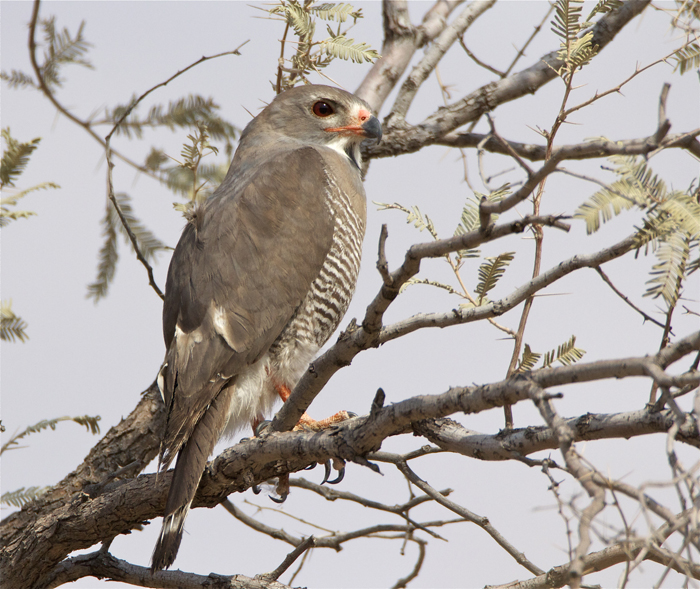 © ExFmem
© ExFmem
Kgalagadi Transfrontier Park, Sept. 2018-Auob Side
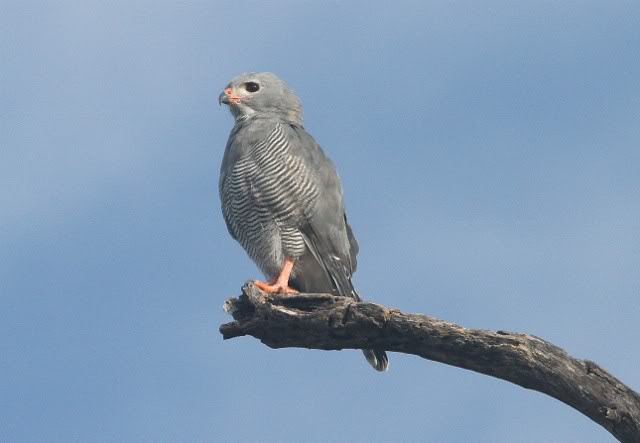 © nan
© nan
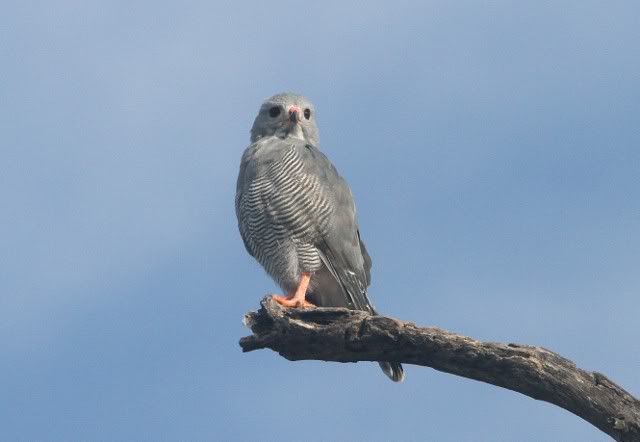 © nan
© nan
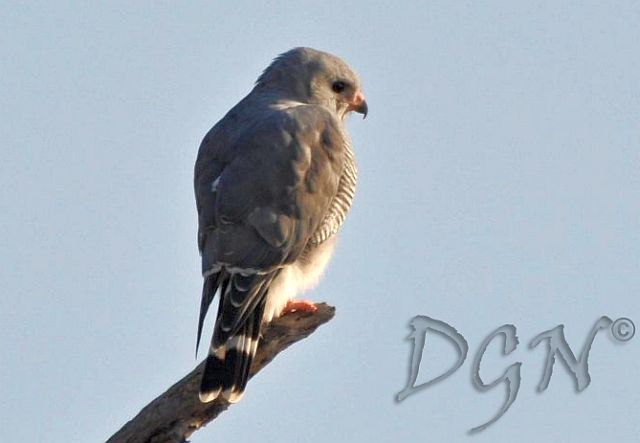 © JustN@ture
© JustN@ture
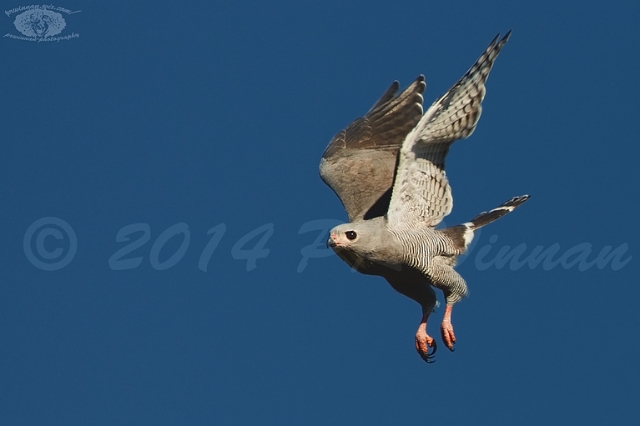 © PRWIN
© PRWIN
Kruger National Park

Kruger National Park, Waterhole Road S65
Links:
http://sabap2.adu.org.za/docs/sabap1/154.pdf
http://sabap2.adu.org.za/spp_summary.ph ... §ion=3
http://www.globalraptors.org/grin/Speci ... pecID=8291
http://www.oiseaux-birds.com/card-lizard-buzzard.html
 © Duke
© DukeKruger National Park
 © ExFmem
© ExFmemKgalagadi Transfrontier Park, Sept. 2018-Auob Side
 © nan
© nan © nan
© nan © JustN@ture
© JustN@ture © PRWIN
© PRWINKruger National Park

Kruger National Park, Waterhole Road S65
Links:
http://sabap2.adu.org.za/docs/sabap1/154.pdf
http://sabap2.adu.org.za/spp_summary.ph ... §ion=3
http://www.globalraptors.org/grin/Speci ... pecID=8291
http://www.oiseaux-birds.com/card-lizard-buzzard.html
Kgalagadi lover… for ever
https://safrounet.piwigo.com/
https://safrounet.piwigo.com/
- nan
- Posts: 26476
- Joined: Thu May 31, 2012 9:41 pm
- Country: Switzerland
- Location: Central Europe
- Contact:
Gabar Goshawk
161. Gabar Goshawk Micronisus gabar, Melierax gabar (Kleinsingvalk)
ORDER ACCIPITRIFORMES. Family: Accipitridae
Description
Size 28-36 cm. Dark red eyes (yellow in juvenile), red cere and legs and plain dove-grey upperparts, throat and breast distinguish it from other similar-sized small raptors. Combination of grey tail with 4-5 blackish bars, and white rump diagnostic. It has the look of a small, slender hawk, rather like a miniature Pale Chanting Goshawk. The broad white rump is visible in flight. Uniform grey throat and breast. White edge to the secondary area. Sexes alike, but female is larger.
The cere and the legs are yellow in juveniles and the plumage is generally browner, with the pale form having less tidy barring on the chest than the adult. Juvenile differs from other juvenile hawks by its white rump.
In melanistic plumage the red (rather than yellow) legs and the strongly barred tail and wings distinguish it from the melanistic form of the Ovambo Sparrowhawk.
Similar species: The larger Ovambo Sparrowhawk has a dark rump barred, not uniform, grey throat and brest. Could be confused also with Lizard Buzzard, but that species has a white throat with a central stripe and a broad, white tail band. The melanistic form of the Gabar Goshawk differs from the melanistic form of Ovambo Sparrowhawk in having white webbing in the retrices and black markings on the scales on the front of the legs, and in lacking white vertical flecks in the tail.
Distribution
Sub-Saharan Africa: widespread but discontinuous range breeding in Senegal, in Mali, Burkina Faso and Ghana, and from south Niger and north Nigeria east to Ethiopia and west Somalia. Range extends south through eastern Africa to eastern Angola. In southern Africa, it is scarce to locally common in Namibia, Botswana, Zimbabwe, western Mozambique and South Africa. Resident in some parts of range, a short-distance migrant in others.
Habitat
It generally prefers open woodland, especially dry Acacia savanna and broad-leaved woodland. In the arid Karoo and Namib Desert, it is generally restricted to tree-lined watercourses, but it may also move into towns.
Movements and migrations
Mainly sedentary, although it may aggregate in the Kruger National Park from March-July.
Diet
It catches birds in very swift flight, either taking them on the wing, or driving them into dense vegetation. Occasionally hunts small mammals, reptiles and insects.
Breeding
Monogamous, territorial solitary nester, performing a courtship display in which the breeding pair chase each other through the trees. The small platform nest is typically built mainly or solely by the female in roughly 2-6 weeks, made from thin twigs and positioned in a vertical fork in the crown of a thorny tree. To supplement the nest, the gabar goshawk is known to collect social spiders on their webs, which are then incorporated into the nest. The function of this unusual practice is unclear but the subsequent webs that spread over the nest probably act as camouflage, whilst the spiders may consume arthropods that otherwise would parasitize the chicks. Egg-laying season is from July-December, peaking from September-November. It lays 2-4 eggs, which are mainly incubated by the female for about 33-38 days. The chicks are are brooded by the female for the first 19-21 days of their lives, while the male gives her food to feed to them. The young leave the nest at about 35-36 days old, becoming fully independent at least one month later.
Call
Piping twi-twi-twi and other similar notes. Listen to Bird Call.
Status
Locally common to scarce resident. Classified as Least Concern (LC) on the IUCN Red List.
ORDER ACCIPITRIFORMES. Family: Accipitridae
Description
Size 28-36 cm. Dark red eyes (yellow in juvenile), red cere and legs and plain dove-grey upperparts, throat and breast distinguish it from other similar-sized small raptors. Combination of grey tail with 4-5 blackish bars, and white rump diagnostic. It has the look of a small, slender hawk, rather like a miniature Pale Chanting Goshawk. The broad white rump is visible in flight. Uniform grey throat and breast. White edge to the secondary area. Sexes alike, but female is larger.
The cere and the legs are yellow in juveniles and the plumage is generally browner, with the pale form having less tidy barring on the chest than the adult. Juvenile differs from other juvenile hawks by its white rump.
In melanistic plumage the red (rather than yellow) legs and the strongly barred tail and wings distinguish it from the melanistic form of the Ovambo Sparrowhawk.
Similar species: The larger Ovambo Sparrowhawk has a dark rump barred, not uniform, grey throat and brest. Could be confused also with Lizard Buzzard, but that species has a white throat with a central stripe and a broad, white tail band. The melanistic form of the Gabar Goshawk differs from the melanistic form of Ovambo Sparrowhawk in having white webbing in the retrices and black markings on the scales on the front of the legs, and in lacking white vertical flecks in the tail.
Distribution
Sub-Saharan Africa: widespread but discontinuous range breeding in Senegal, in Mali, Burkina Faso and Ghana, and from south Niger and north Nigeria east to Ethiopia and west Somalia. Range extends south through eastern Africa to eastern Angola. In southern Africa, it is scarce to locally common in Namibia, Botswana, Zimbabwe, western Mozambique and South Africa. Resident in some parts of range, a short-distance migrant in others.
Habitat
It generally prefers open woodland, especially dry Acacia savanna and broad-leaved woodland. In the arid Karoo and Namib Desert, it is generally restricted to tree-lined watercourses, but it may also move into towns.
Movements and migrations
Mainly sedentary, although it may aggregate in the Kruger National Park from March-July.
Diet
It catches birds in very swift flight, either taking them on the wing, or driving them into dense vegetation. Occasionally hunts small mammals, reptiles and insects.
Breeding
Monogamous, territorial solitary nester, performing a courtship display in which the breeding pair chase each other through the trees. The small platform nest is typically built mainly or solely by the female in roughly 2-6 weeks, made from thin twigs and positioned in a vertical fork in the crown of a thorny tree. To supplement the nest, the gabar goshawk is known to collect social spiders on their webs, which are then incorporated into the nest. The function of this unusual practice is unclear but the subsequent webs that spread over the nest probably act as camouflage, whilst the spiders may consume arthropods that otherwise would parasitize the chicks. Egg-laying season is from July-December, peaking from September-November. It lays 2-4 eggs, which are mainly incubated by the female for about 33-38 days. The chicks are are brooded by the female for the first 19-21 days of their lives, while the male gives her food to feed to them. The young leave the nest at about 35-36 days old, becoming fully independent at least one month later.
Call
Piping twi-twi-twi and other similar notes. Listen to Bird Call.
Status
Locally common to scarce resident. Classified as Least Concern (LC) on the IUCN Red List.
Kgalagadi lover… for ever
https://safrounet.piwigo.com/
https://safrounet.piwigo.com/
- nan
- Posts: 26476
- Joined: Thu May 31, 2012 9:41 pm
- Country: Switzerland
- Location: Central Europe
- Contact:
Gabar Goshawk Photos
161. Gabar Goshawk Micronisus gabar, Melierax gabar
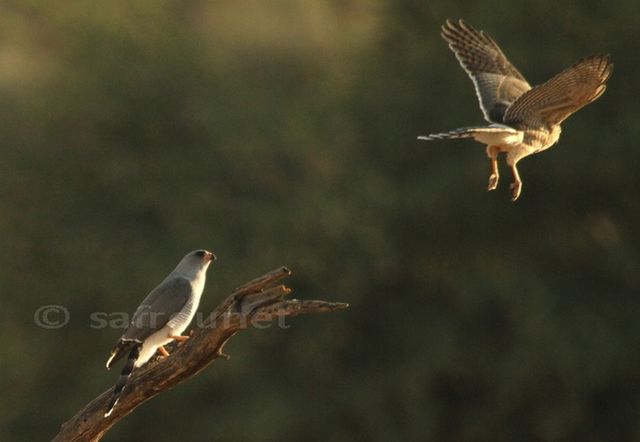 © nan
© nan
Kgalagadi Transfrontier Park
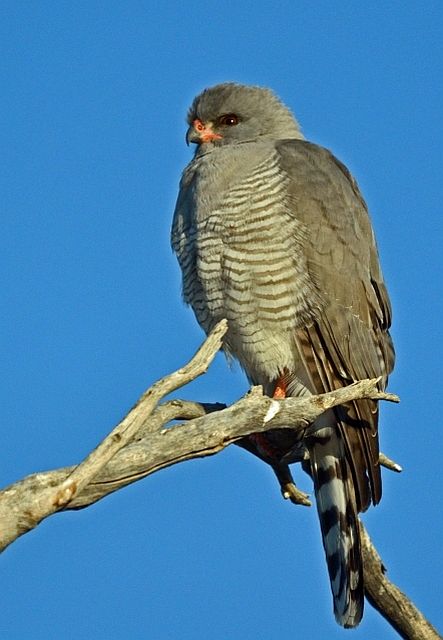 © BluTuna
© BluTuna
Kgalagadi Transfrontier Park
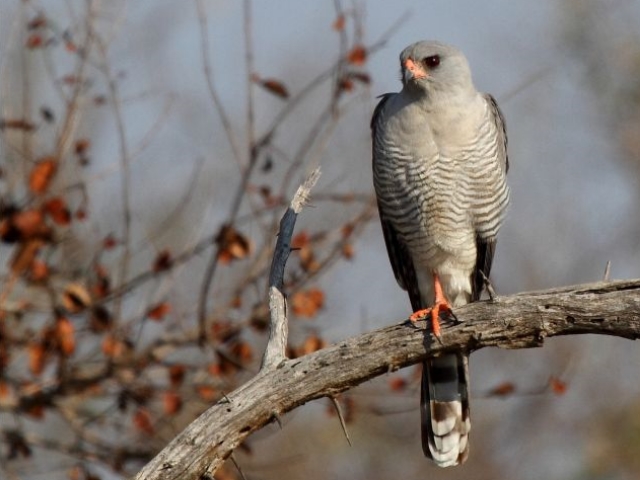 © Duke
© Duke
Kruger National Park
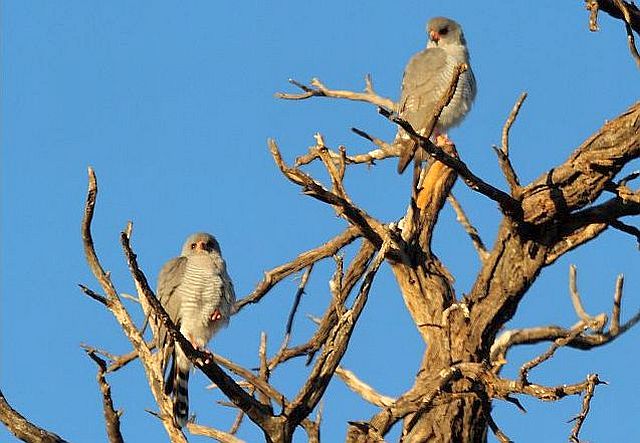 © Sharifa & Duke
© Sharifa & Duke
 © Mel
© Mel
 © Sharifa
© Sharifa
Mountain Zebra National Park
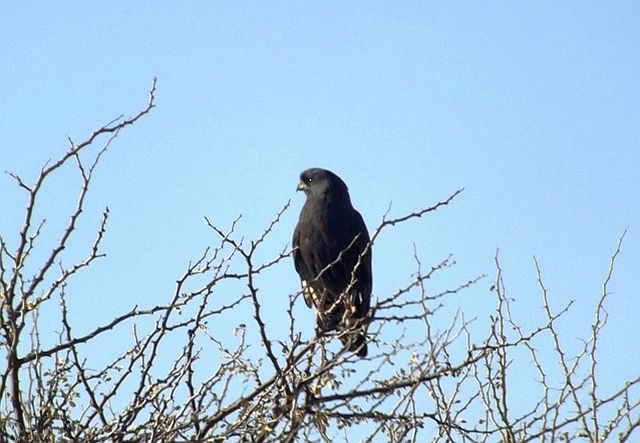 © pooky
© pooky
Melanistic morph
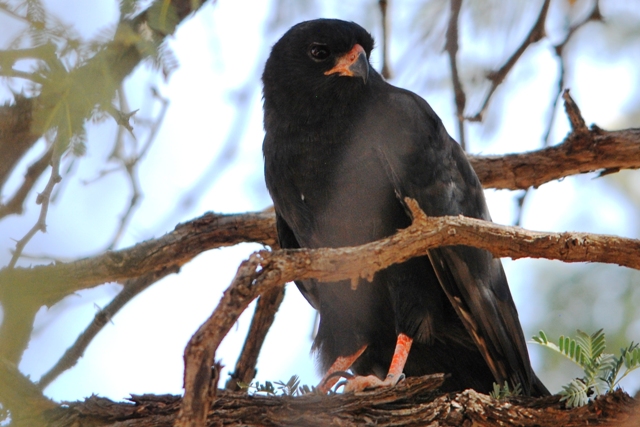 © Mel
© Mel
Melanistic morph
 © ExFmem
© ExFmem
Juvenile, Kgalagadi Transfrontier Park
 © Mel
© Mel
Juvenile
 © leachy
© leachy
Juvenile

Juvenile

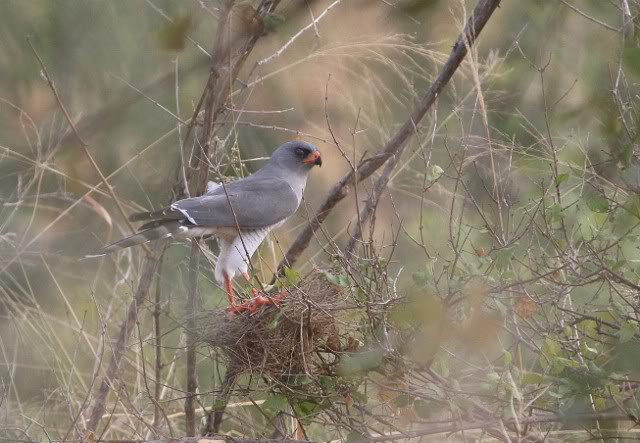

Links:
http://sabap2.adu.org.za/docs/sabap1/161.pdf
http://sabap2.adu.org.za/spp_summary.ph ... §ion=3
Birds of Botswana
http://www.globalraptors.org/grin/Speci ... pecID=8303
http://www.oiseaux-birds.com/card-gabar-goshawk.html
http://www.arkive.org/gabar-goshawk/melierax-gabar/
 © nan
© nanKgalagadi Transfrontier Park
 © BluTuna
© BluTunaKgalagadi Transfrontier Park
 © Duke
© DukeKruger National Park
 © Sharifa & Duke
© Sharifa & Duke © Mel
© Mel © Sharifa
© SharifaMountain Zebra National Park
 © pooky
© pookyMelanistic morph
 © Mel
© MelMelanistic morph
Juvenile, Kgalagadi Transfrontier Park
 © Mel
© MelJuvenile
 © leachy
© leachyJuvenile

Juvenile



Links:
http://sabap2.adu.org.za/docs/sabap1/161.pdf
http://sabap2.adu.org.za/spp_summary.ph ... §ion=3
Birds of Botswana
http://www.globalraptors.org/grin/Speci ... pecID=8303
http://www.oiseaux-birds.com/card-gabar-goshawk.html
http://www.arkive.org/gabar-goshawk/melierax-gabar/
Kgalagadi lover… for ever
https://safrounet.piwigo.com/
https://safrounet.piwigo.com/
- Flutterby
- Posts: 44029
- Joined: Sat May 19, 2012 12:28 pm
- Country: South Africa
- Location: Gauteng, South Africa
- Contact:
Dark Chanting Goshawk
163. Dark Chanting Goshawk Melierax metabates (Donkersingvalk)
ORDER ACCIPITRIFORMES. Family: Accipitridae
Description
43-56 cm. Dark grey with horizontal stripes across lower chest; red beak and cere and red unfeathered legs. In flight, the wings are grey with black tips. The rump and secondaries are grey not white. Sexes are alike.
Similar species: Darker grey than Pale Chanting Goshawk. At rest, the grey forewing does not contrast with the rest of the wing as it does in Pale Chanting Goshawk.
Juveniles have a darker brown breast band than juvenile Pale Chanting Goshawk.
Distribution
Occupies much of sub-Saharan Africa, excluding the lowland equatorial forest of the DRC and West Africa. In southern Africa, it is scarce to locally common in north-eastern Namibia (including the Caprivi Strip), northern Botswana, Zimbabwe, Mozambique and north-eastern South Africa. Range overlaps narrowly with Pale Chanting Goshawk.
Habitat
Thornveld and open, broadleafed woodlands.
Diet
Its diet consists primarily of lizards and snakes although it will also take birds and small mammals. it typically hunts from a perch, from which it descends to catch prey on the ground or in the air.
Breeding
Monogamous, territorial solitary nester. Both sexes perform a courtship display, in which the male repeatedly dives at the female, who presents her claws. Both sexes build the nest, which consists of a saucer-shaped platform of sticks, decorated with spider web and sometimes cemented with mud. The interior is lined with a variety of materials, including stones, mud rags, skin, dung, hair, birds nests, bark, seed pods and grass. The nest is typically placed in a tree, such as Mopane, Knob thorn, Marula. Egg-laying season is from July-November, peaking from August-October. It lays 1-2, rarely 3 eggs, which are mainly incubated by the female for about 36-38 days, while the male regularly feeds her at the nest. At first, the chicks are cared for by the female, while the male provides them all with food. The young leave the nest at about 50 days old, becoming fully independent roughly 3-8 months later. They disperse from their parents territory at the beginning of the following breeding season,
Status
Scarce resident.
ORDER ACCIPITRIFORMES. Family: Accipitridae
Description
43-56 cm. Dark grey with horizontal stripes across lower chest; red beak and cere and red unfeathered legs. In flight, the wings are grey with black tips. The rump and secondaries are grey not white. Sexes are alike.
Similar species: Darker grey than Pale Chanting Goshawk. At rest, the grey forewing does not contrast with the rest of the wing as it does in Pale Chanting Goshawk.
Juveniles have a darker brown breast band than juvenile Pale Chanting Goshawk.
Distribution
Occupies much of sub-Saharan Africa, excluding the lowland equatorial forest of the DRC and West Africa. In southern Africa, it is scarce to locally common in north-eastern Namibia (including the Caprivi Strip), northern Botswana, Zimbabwe, Mozambique and north-eastern South Africa. Range overlaps narrowly with Pale Chanting Goshawk.
Habitat
Thornveld and open, broadleafed woodlands.
Diet
Its diet consists primarily of lizards and snakes although it will also take birds and small mammals. it typically hunts from a perch, from which it descends to catch prey on the ground or in the air.
Breeding
Monogamous, territorial solitary nester. Both sexes perform a courtship display, in which the male repeatedly dives at the female, who presents her claws. Both sexes build the nest, which consists of a saucer-shaped platform of sticks, decorated with spider web and sometimes cemented with mud. The interior is lined with a variety of materials, including stones, mud rags, skin, dung, hair, birds nests, bark, seed pods and grass. The nest is typically placed in a tree, such as Mopane, Knob thorn, Marula. Egg-laying season is from July-November, peaking from August-October. It lays 1-2, rarely 3 eggs, which are mainly incubated by the female for about 36-38 days, while the male regularly feeds her at the nest. At first, the chicks are cared for by the female, while the male provides them all with food. The young leave the nest at about 50 days old, becoming fully independent roughly 3-8 months later. They disperse from their parents territory at the beginning of the following breeding season,
Status
Scarce resident.
- Flutterby
- Posts: 44029
- Joined: Sat May 19, 2012 12:28 pm
- Country: South Africa
- Location: Gauteng, South Africa
- Contact:
Dark Chanting Goshawk Photos
163. Dark Chanting Goshawk Melierax metabates
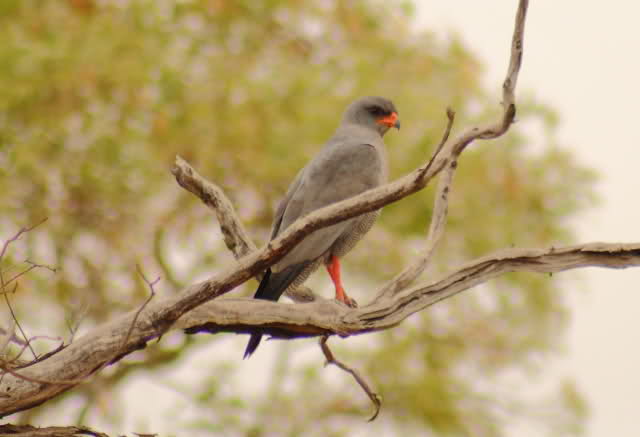 © Flutterby
© Flutterby
 © leachy
© leachy
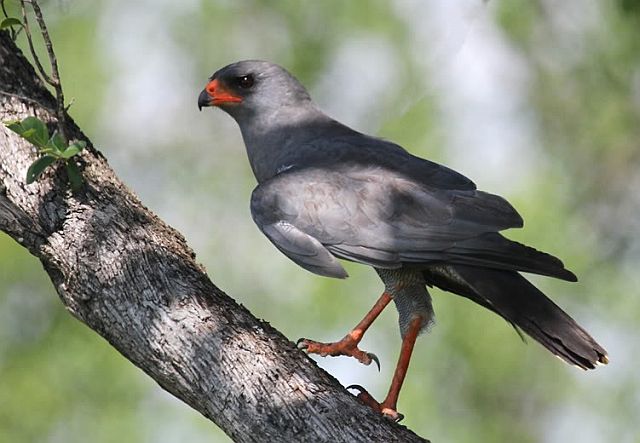 © leachy
© leachy
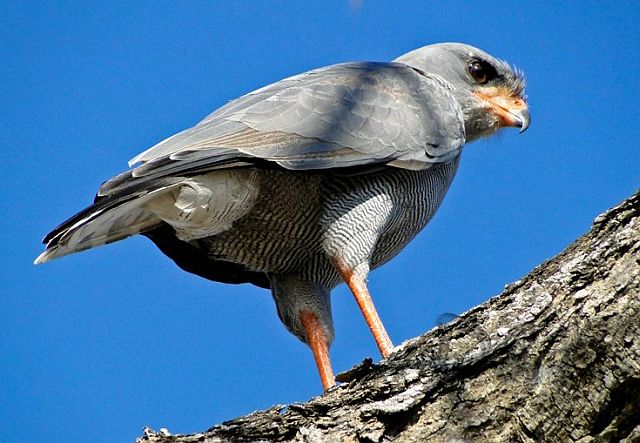 © JustN@ture
© JustN@ture
 © Bushcraft
© Bushcraft
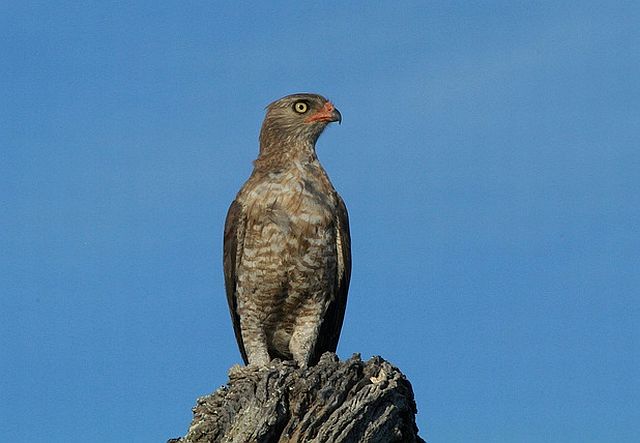 © flying cheetah
© flying cheetah
Juvenile
 © flying cheetah
© flying cheetah
Juvenile, Kruger National Park
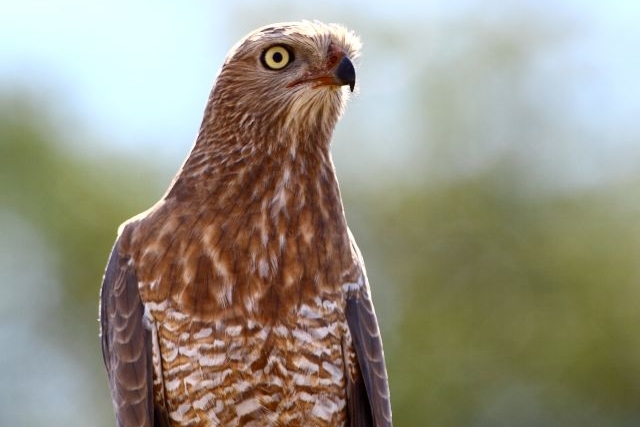 © Duke
© Duke
Juvenile, Kruger National Park
Links:
http://sabap2.adu.org.za/docs/sabap1/163.pdf
http://sabap2.adu.org.za/spp_summary.ph ... §ion=3
http://www.globalraptors.org/grin/Speci ... pecID=8296
http://www.oiseaux-birds.com/card-dark- ... shawk.html
 © Flutterby
© Flutterby © leachy
© leachy © leachy
© leachy © JustN@ture
© JustN@ture © Bushcraft
© Bushcraft © flying cheetah
© flying cheetahJuvenile
 © flying cheetah
© flying cheetahJuvenile, Kruger National Park
 © Duke
© DukeJuvenile, Kruger National Park
Links:
http://sabap2.adu.org.za/docs/sabap1/163.pdf
http://sabap2.adu.org.za/spp_summary.ph ... §ion=3
http://www.globalraptors.org/grin/Speci ... pecID=8296
http://www.oiseaux-birds.com/card-dark- ... shawk.html
- Mel
- Global Moderator
- Posts: 26737
- Joined: Sat May 19, 2012 12:31 pm
- Country: Germany
- Location: Föhr
- Contact:
Pale Chanting Goshawk
162. Pale Chanting Goshawk Melierax canorus (Witkrussperwer, Kleinsingvalk)
Order: Accipitriformes. Family: Accipitridae
Description
Length 46-65 cm; wingspan 105-115 cm. Pale grey raptor with white rump.
The adult upper plumage is grey except of the white (not barred) rump. The upper tail feathers are barred grey and white turning darker towards the center of the tail. The lower chest, abdomen, thighs and most of the tail feathers below are finely barred dark grey and white. The longer outer wing feathers (primaries) are black with grey on the outer webs. The shorter inner flight feathers (secondaries) are pale grey with narrow white tips and white specs on the inner webs. (White secondaries in flight visible.) The eyes are reddish-brown; the cere is orange; the long legs are orange-reddish.
Juveniles have a brownish upper plumage with a brown-white barred tail. The chin, throat, upper chest are brown. The rest of the under plumage are barred brown and white. The tail is barred greyish above and brownish when seen from below. The legs are yellow, turning reddish as they reach adulthood. Eyes are yellow.
Distribution
Near-endemic to southern Africa, occurring from south-western Angola to Namibia, Botswana, south-western Zimbabwe and the western half of South Africa.
Habitat
Arid region, Karoo scrubs, Kalahari woodland, Mopane woodland, areas with patches of open ground and perches for hunt.
Diet
It feeds on rodents, lizards, snakes and insects. It may hunt birds (as quails) and hares. It does most of its hunting from a perch, descending to the ground to pursue and strike it's prey. It sometimes forages in family groups, so that some of the family members can flush prey, which another family member hunts down. It also follows Black-backed jackals, Honey badgers, Slender mongooses, Rock monitors and Cape cobras, catching the prey that they disturb.
Breeding
Mainly monogamous, but in the Little Karoo it may be cooperatively polyandrous, as one female can mate with a primary male, while another male assists them with breeding activities (occasionally mating with the female). This behaviour only occurs in high-quality territories, which have to be viciously defended. In fact, males from opposing territories sometimes fight to the death. The nest is built by both sexes (including an additional male if it they are a trio), consisting of a stick platform with a central cup. This can be lined with a wide variety of materials, including dung, regurgitated carnivore pellets, hair, wool, penduline-tit and prinia nests, Common ostrich feathers, webs of Social spider, grass, fabric, paper, string, rope, plastic bags and cabling. When it builds a new nest each breeding season, it often moves the lining from the old structure to the new one. The nest can be placed in a variety of sites. Egg-laying season is from May-December, peaking from July-November. It lays 1-2 pale bluish or greenish white eggs, which are incubated by both sexes for about 35 days, both vigorously defending the eggs from intruders. At first, the chicks are brooded and fed by the female, with food provided by the male or males; she later joins them on hunting trips. They leave the nest at about 44-51 days old, becoming fully independent roughly 30-81 days, after which they remain in their parents' territory for at least one more year.
Call
During the breeding season, the males make a series of tuneful whistling calls from a tree-top perch that are described as kleeuu, kleeuu-ku-ku-ku. Listen to Bird Call.
Status
Near endemic. Common resident, sedentary but moves in response to conditions and food availability.
Order: Accipitriformes. Family: Accipitridae
Description
Length 46-65 cm; wingspan 105-115 cm. Pale grey raptor with white rump.
The adult upper plumage is grey except of the white (not barred) rump. The upper tail feathers are barred grey and white turning darker towards the center of the tail. The lower chest, abdomen, thighs and most of the tail feathers below are finely barred dark grey and white. The longer outer wing feathers (primaries) are black with grey on the outer webs. The shorter inner flight feathers (secondaries) are pale grey with narrow white tips and white specs on the inner webs. (White secondaries in flight visible.) The eyes are reddish-brown; the cere is orange; the long legs are orange-reddish.
Juveniles have a brownish upper plumage with a brown-white barred tail. The chin, throat, upper chest are brown. The rest of the under plumage are barred brown and white. The tail is barred greyish above and brownish when seen from below. The legs are yellow, turning reddish as they reach adulthood. Eyes are yellow.
Distribution
Near-endemic to southern Africa, occurring from south-western Angola to Namibia, Botswana, south-western Zimbabwe and the western half of South Africa.
Habitat
Arid region, Karoo scrubs, Kalahari woodland, Mopane woodland, areas with patches of open ground and perches for hunt.
Diet
It feeds on rodents, lizards, snakes and insects. It may hunt birds (as quails) and hares. It does most of its hunting from a perch, descending to the ground to pursue and strike it's prey. It sometimes forages in family groups, so that some of the family members can flush prey, which another family member hunts down. It also follows Black-backed jackals, Honey badgers, Slender mongooses, Rock monitors and Cape cobras, catching the prey that they disturb.
Breeding
Mainly monogamous, but in the Little Karoo it may be cooperatively polyandrous, as one female can mate with a primary male, while another male assists them with breeding activities (occasionally mating with the female). This behaviour only occurs in high-quality territories, which have to be viciously defended. In fact, males from opposing territories sometimes fight to the death. The nest is built by both sexes (including an additional male if it they are a trio), consisting of a stick platform with a central cup. This can be lined with a wide variety of materials, including dung, regurgitated carnivore pellets, hair, wool, penduline-tit and prinia nests, Common ostrich feathers, webs of Social spider, grass, fabric, paper, string, rope, plastic bags and cabling. When it builds a new nest each breeding season, it often moves the lining from the old structure to the new one. The nest can be placed in a variety of sites. Egg-laying season is from May-December, peaking from July-November. It lays 1-2 pale bluish or greenish white eggs, which are incubated by both sexes for about 35 days, both vigorously defending the eggs from intruders. At first, the chicks are brooded and fed by the female, with food provided by the male or males; she later joins them on hunting trips. They leave the nest at about 44-51 days old, becoming fully independent roughly 30-81 days, after which they remain in their parents' territory for at least one more year.
Call
During the breeding season, the males make a series of tuneful whistling calls from a tree-top perch that are described as kleeuu, kleeuu-ku-ku-ku. Listen to Bird Call.
Status
Near endemic. Common resident, sedentary but moves in response to conditions and food availability.
God put me on earth to accomplish a certain amount of things. Right now I'm so far behind that I'll never die.
- Mel
- Global Moderator
- Posts: 26737
- Joined: Sat May 19, 2012 12:31 pm
- Country: Germany
- Location: Föhr
- Contact:
Pale Chanting Goshawk Photos
162. Pale Chanting Goshawk Melierax canorus
 © Mel
© Mel
Adult
 © Michele Nel
© Michele Nel
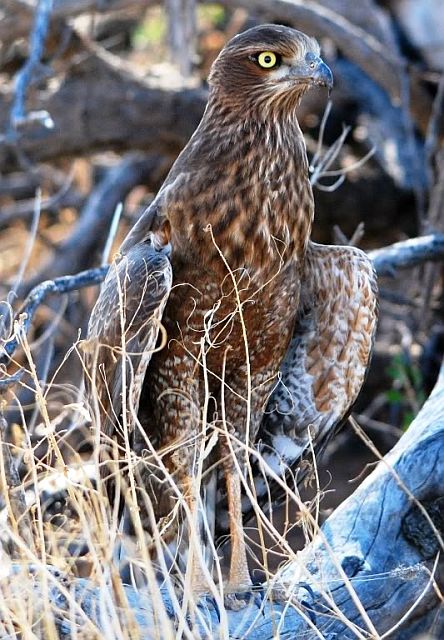
Juvenile
 © Dewi
© Dewi
Juvenile
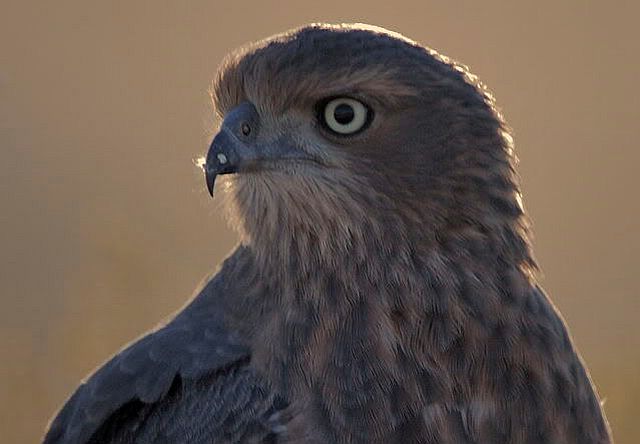 © Dewi
© Dewi
Juvenile
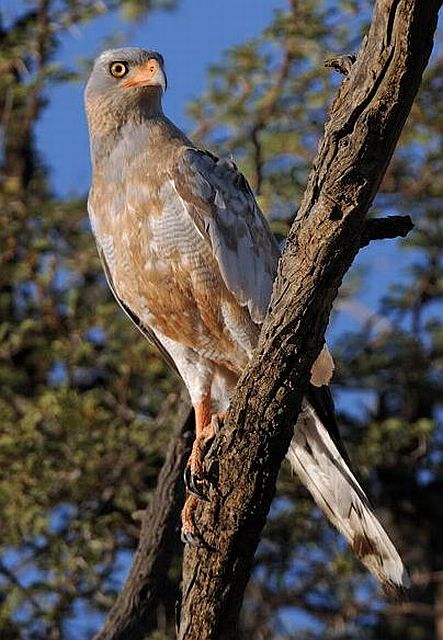 © Dewi
© Dewi
Subadult
 © ExFmem
© ExFmem
PCG with Mole snake
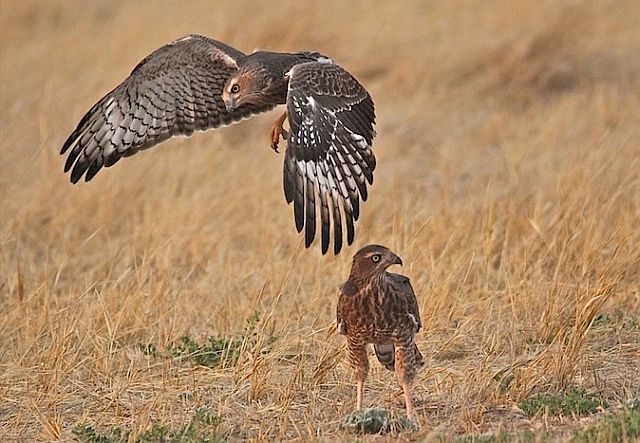 © ExFmem
© ExFmem
Links:
Species text Sabap1: http://sabap2.adu.org.za/docs/sabap1/162.pdf
Sabap2: http://sabap2.adu.org.za/spp_summary.ph ... §ion=3
Wild Magazine: The Singing Goshawk
Global Raptor Information Network
Oiseaux net
 © Mel
© MelAdult
 © Michele Nel
© Michele Nel
Juvenile
 © Dewi
© DewiJuvenile
 © Dewi
© DewiJuvenile
 © Dewi
© DewiSubadult
 © ExFmem
© ExFmemPCG with Mole snake
 © ExFmem
© ExFmemLinks:
Species text Sabap1: http://sabap2.adu.org.za/docs/sabap1/162.pdf
Sabap2: http://sabap2.adu.org.za/spp_summary.ph ... §ion=3
Wild Magazine: The Singing Goshawk
Global Raptor Information Network
Oiseaux net
God put me on earth to accomplish a certain amount of things. Right now I'm so far behind that I'll never die.
- nan
- Posts: 26476
- Joined: Thu May 31, 2012 9:41 pm
- Country: Switzerland
- Location: Central Europe
- Contact:
African Goshawk
160. African Goshawk Accipiter tachiro (Afrikaanse Sperwer)
Order: Accipitriformes. Family: Accipitridae
Description
Size 36-46 cm. This species is finely barred red-brown on the front, has no white on the rump, and its yellow eye and grey or greenish cere distinguish the adult from other similar-looking hawks.
Cere colour is always a little variable, so although often cited as a useful distinguishing feature, it should be used with caution (and only in combination with other features).
Sexes are highly dimorphic, the small males are bluish grey above and the underparts are white, finely barred rufous, and have two white spots in the tail (like Little Sparrowhawk; the tail is indistinctly barred, and has two white spots on the upper side.
The large females are dark brown above and barred brown below (less finely barred than the male), and lack the tail spots.
In both sexes the cere, eyes and legs are yellow; the underwing is barred, and the underwing coverts are of a similar colour to that of the barring on the breast.
The subspecies A. t. tachiro has a distinct brown wash to underparts; A. t. sparsimfasciatus has fine gray barring with little brown.
East and south-central African race sparsimfasciatus also has dark morph
Juvenile is boldly spotted on the front, there is a dark streak down the centre of the throat, and the eyebrow is white.
Juvenile is distinguished from juvenile Little Sparrowhawk by the grey cere and from juvenile African Cuckoo Hawk by its smaller size, longer legs and the lack of crest.
Distribution
Most of Sub-Saharan Africa: from Senegal in the West and Eritrea in the East to South Africa in the South. In southern Africa, it is scarce to locally common in north-eastern Namibia (including the Caprivi Strip), Zimbabwe, Mozambique and South Africa.
Habitat
Evergreen and riverine forests, tall mature woodland and well-wooded suburbia.
Diet
Prey comprises mainly birds (usually bulbul size or smaller), but includes small mammals and lizards. Hunting is usually done using a quick dash from a perch in cover, and birds are caught both in flight and on the ground.
Breeding
Monogamous, territorial solitary nester, performing a courtship display in which either the male, female or both of them together fly in an undulated flight while calling loudly, sometimes finishing with a steep dive. The nest is built mainly by the female, consisting of a stick platform thickly lined with green leaves, such as pine needles, lichen and mistletoe. It is typically placed on a branch away from the main trunk of a tree, especially if it has dense foliage, although it may also build it on top of an old Hadeda ibis nest, sometimes taking over the nest of a Little sparrowhawk instead of build its own. Egg-laying season is from July-December, peaking from September-November. It lays 1-3 eggs, which are incubated mainly or solely by the female for about 35-37 days, while the male feeds her regularly at the nest. The chicks are fed by both parents, leaving the nest after about 30-35 days but remaining in the nest tree vicinity for another six weeks or so. The young become fully independent roughly 1-3 months after fledgling.
Call
A sharp tchit-tchit-tchit (at two-second intervals) that has been likened to the click of two stones being struck together. Listen to Bird Call.
Status
Common resident.
Order: Accipitriformes. Family: Accipitridae
Description
Size 36-46 cm. This species is finely barred red-brown on the front, has no white on the rump, and its yellow eye and grey or greenish cere distinguish the adult from other similar-looking hawks.
Cere colour is always a little variable, so although often cited as a useful distinguishing feature, it should be used with caution (and only in combination with other features).
Sexes are highly dimorphic, the small males are bluish grey above and the underparts are white, finely barred rufous, and have two white spots in the tail (like Little Sparrowhawk; the tail is indistinctly barred, and has two white spots on the upper side.
The large females are dark brown above and barred brown below (less finely barred than the male), and lack the tail spots.
In both sexes the cere, eyes and legs are yellow; the underwing is barred, and the underwing coverts are of a similar colour to that of the barring on the breast.
The subspecies A. t. tachiro has a distinct brown wash to underparts; A. t. sparsimfasciatus has fine gray barring with little brown.
East and south-central African race sparsimfasciatus also has dark morph
Juvenile is boldly spotted on the front, there is a dark streak down the centre of the throat, and the eyebrow is white.
Juvenile is distinguished from juvenile Little Sparrowhawk by the grey cere and from juvenile African Cuckoo Hawk by its smaller size, longer legs and the lack of crest.
Distribution
Most of Sub-Saharan Africa: from Senegal in the West and Eritrea in the East to South Africa in the South. In southern Africa, it is scarce to locally common in north-eastern Namibia (including the Caprivi Strip), Zimbabwe, Mozambique and South Africa.
Habitat
Evergreen and riverine forests, tall mature woodland and well-wooded suburbia.
Diet
Prey comprises mainly birds (usually bulbul size or smaller), but includes small mammals and lizards. Hunting is usually done using a quick dash from a perch in cover, and birds are caught both in flight and on the ground.
Breeding
Monogamous, territorial solitary nester, performing a courtship display in which either the male, female or both of them together fly in an undulated flight while calling loudly, sometimes finishing with a steep dive. The nest is built mainly by the female, consisting of a stick platform thickly lined with green leaves, such as pine needles, lichen and mistletoe. It is typically placed on a branch away from the main trunk of a tree, especially if it has dense foliage, although it may also build it on top of an old Hadeda ibis nest, sometimes taking over the nest of a Little sparrowhawk instead of build its own. Egg-laying season is from July-December, peaking from September-November. It lays 1-3 eggs, which are incubated mainly or solely by the female for about 35-37 days, while the male feeds her regularly at the nest. The chicks are fed by both parents, leaving the nest after about 30-35 days but remaining in the nest tree vicinity for another six weeks or so. The young become fully independent roughly 1-3 months after fledgling.
Call
A sharp tchit-tchit-tchit (at two-second intervals) that has been likened to the click of two stones being struck together. Listen to Bird Call.
Status
Common resident.
Kgalagadi lover… for ever
https://safrounet.piwigo.com/
https://safrounet.piwigo.com/
- nan
- Posts: 26476
- Joined: Thu May 31, 2012 9:41 pm
- Country: Switzerland
- Location: Central Europe
- Contact:
African Goshawk Photos
160. African Goshawk Accipiter tachiro
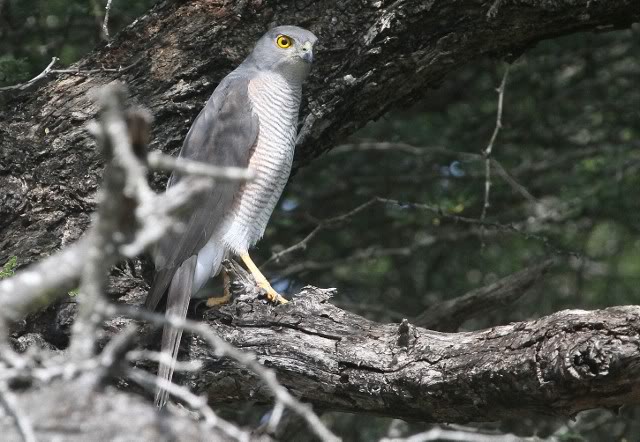 © nan
© nan
Male
 © Dewi
© Dewi
Female
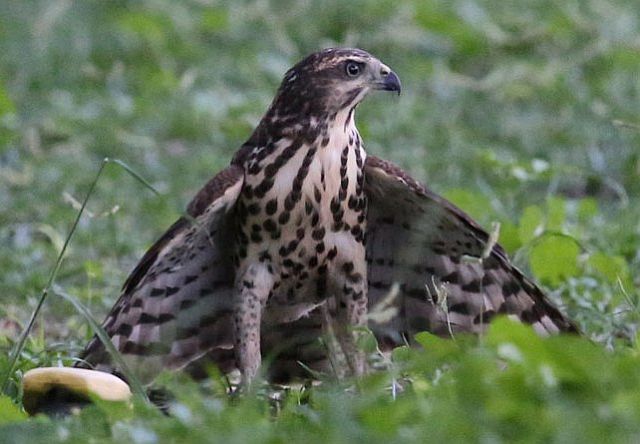 © Pumbaa
© Pumbaa
Juvenile
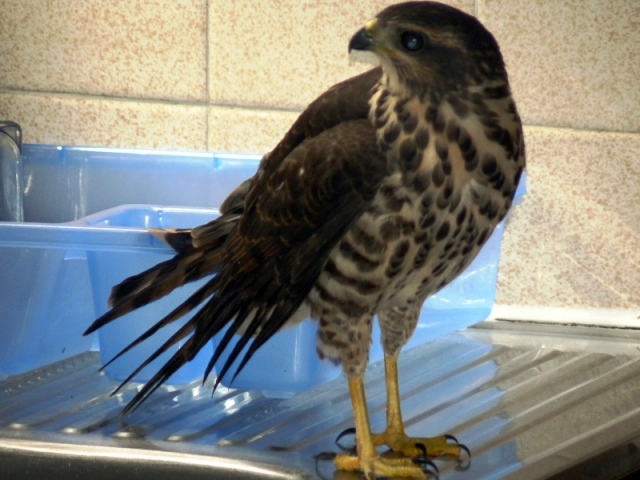 Juvenile © Richprins
Juvenile © Richprins
Links:
Species text Sabap1
Sabap2
Birds of Botswana
Global Raptor Information Network
 © nan
© nanMale
 © Dewi
© DewiFemale
 © Pumbaa
© PumbaaJuvenile
 Juvenile © Richprins
Juvenile © RichprinsLinks:
Species text Sabap1
Sabap2
Birds of Botswana
Global Raptor Information Network
Kgalagadi lover… for ever
https://safrounet.piwigo.com/
https://safrounet.piwigo.com/


